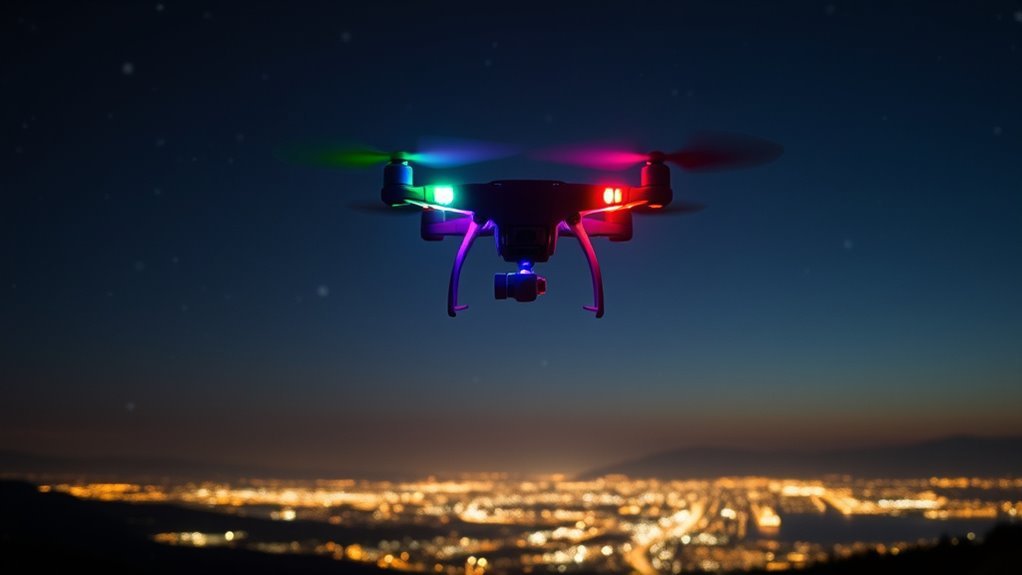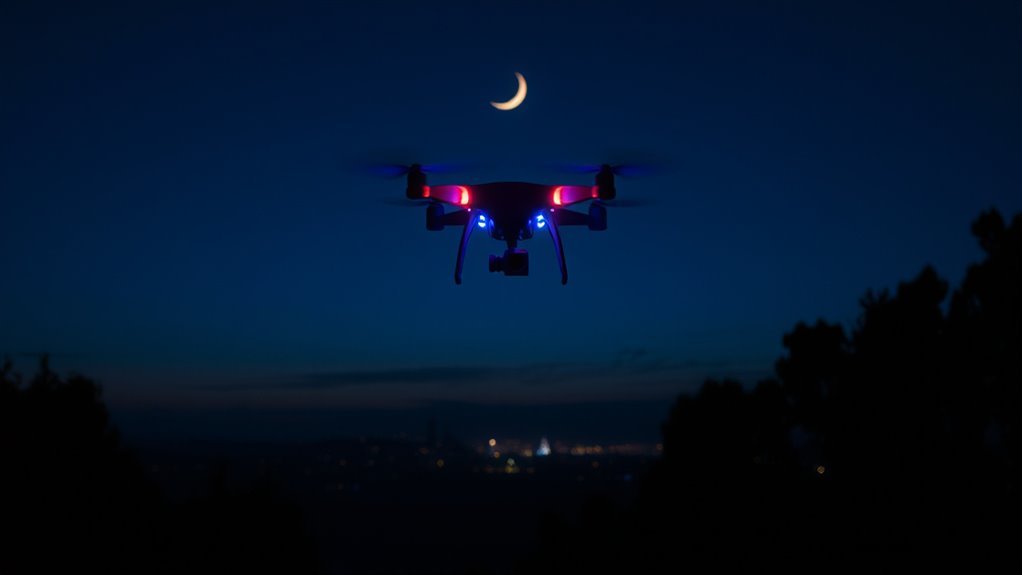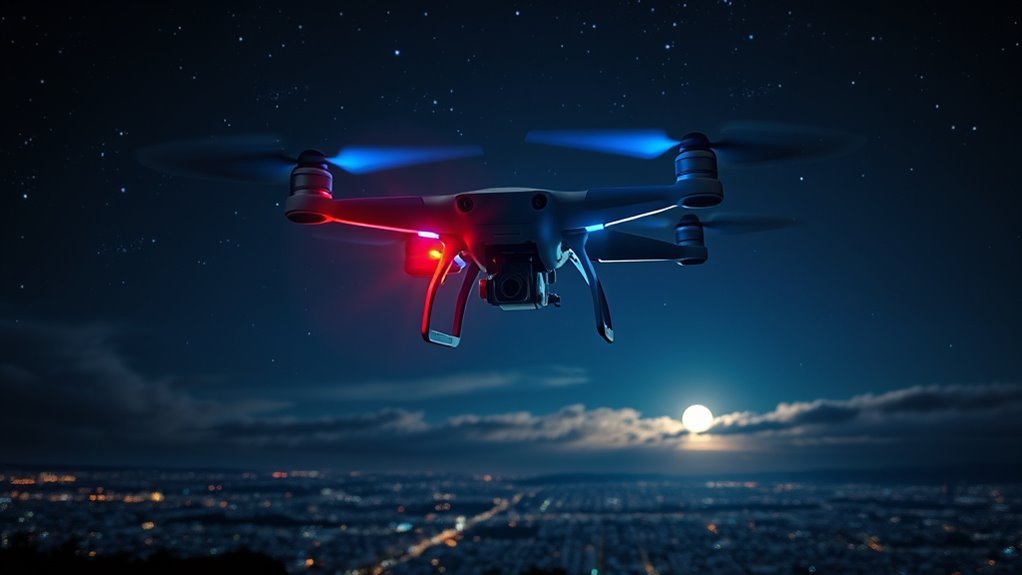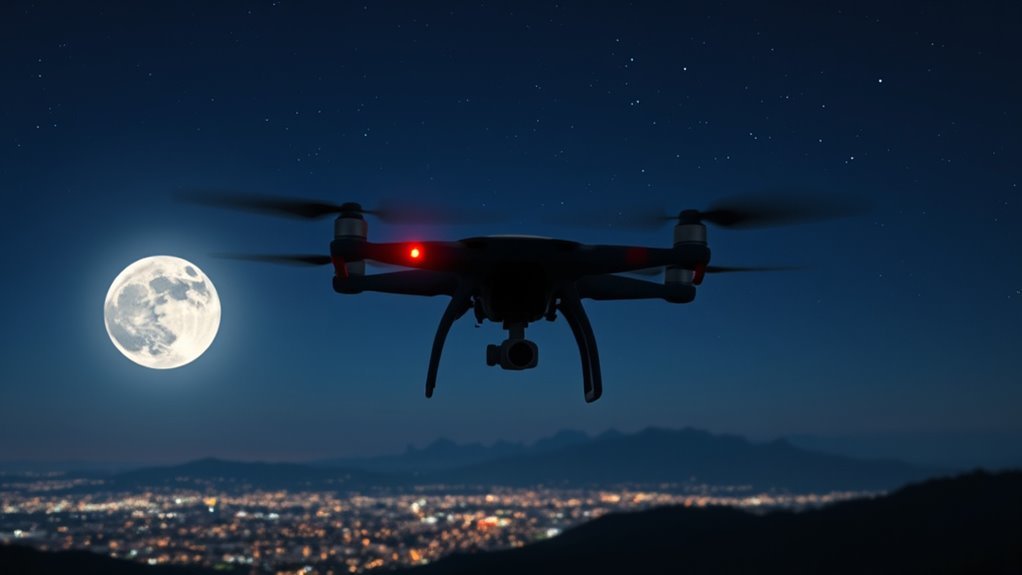To legally fly your drone at night, you must comply with FAA regulations, including having anti-collision lights visible from three statute miles. You need to obtain a waiver under Part 107, detailing your risk mitigation strategies. Make certain your equipment is equipped for nighttime and perform a thorough pre-flight checklist, confirming your flight plan addresses hazards and legal boundaries. This guarantees safety and compliance, and there’s much more to contemplate for successful night operations.
Understanding Night Flying Regulations

Before you take your drone to the night sky, it’s essential to understand the regulations governing night flying. The Federal Aviation Administration (FAA) has specific nighttime regulations that guarantee safety while allowing you the freedom to fly after dark. You must equip your drone with appropriate lighting to maintain minimum drone visibility, making it visible from a distance of three statute miles. This is critical for avoiding collisions and guaranteeing compliance with the law. Additionally, flying must occur within your visual line of sight, which can be challenging at night. Always check local laws, as they may impose further restrictions. Stay informed and prepared, so you can enjoy the thrill of nighttime flying without facing unnecessary penalties.
Obtaining Necessary Permissions

Flying your drone at night not only requires adherence to regulations but also obtaining the necessary permissions. To legally operate your drone after dark, you’ll need to secure specific drone permits and flight authorization from the Federal Aviation Administration (FAA). Start by submitting a request for a waiver under Part 107, detailing how you’ll mitigate nighttime risks. Verify your application includes safety measures like anti-collision lighting and operational guidelines. It’s essential to provide thorough information to expedite approval. Additionally, check local laws, as some areas may have restrictions that necessitate further permissions. Once you’ve obtained all required permits, you can enjoy the freedom of nighttime flying while staying compliant with all regulations.
Equipment Requirements for Night Flying

When preparing to fly your drone at night, verifying you have the right equipment is essential for safety and compliance. First, your drone must be equipped with anti-collision lights visible from at least three statute miles. This isn’t just a suggestion; it’s a regulatory requirement. Additionally, consider using night vision accessories to enhance visibility and navigation in low-light conditions. These drone accessories can greatly improve your situational awareness, allowing you to spot obstacles more easily. Confirm your drone has a reliable battery, as night flying can drain power faster. Finally, a quality camera with low-light capabilities can help capture stunning nighttime footage while keeping you compliant with regulations. Stay prepared, and enjoy the freedom of night flying!
Pre-Flight Checklist for Night Operations
Before you take off at night, it’s important to verify you have the required lighting equipment to enhance visibility and comply with regulations. Conduct a thorough pre-flight safety inspection to confirm all systems are functioning correctly. Finally, prepare a detailed flight plan that accounts for potential hazards and guarantees you remain within legal boundaries during your night operations.
Required Lighting Equipment
To guarantee safe night operations, you’ll need specific lighting equipment for your drone. FAA lighting regulations require that your drone be equipped with anti-collision lights visible from at least three statute miles. These drone lights should be capable of being seen from all directions to maximize safety. Additionally, you’ll want to take into account forward-facing white lights to illuminate your flight path, ensuring you can navigate effectively in low visibility. Make sure to check that the lights are properly mounted and functional before each flight. Compliance with these lighting regulations not only enhances safety but also allows you to enjoy the freedom of flying your drone at night without worry. Don’t overlook this critical aspect of your night operations!
Pre-Flight Safety Inspection
Conducting a thorough pre-flight safety inspection is essential for successful night operations, and it should include at least five critical checks. This checklist guarantees your drone’s reliability and adherence to safety protocols, so you can enjoy your flying experience.
- Battery Charge: Verify the battery is fully charged and securely connected.
- Propeller Condition: Check for any cracks or damage that could affect flight stability.
- Lighting Functionality: Confirm that all required lights are operational for visibility.
- GPS Signal: Verify that your drone has a strong GPS signal to guarantee accurate positioning.
Flight Plan Preparation
A well-structured flight plan is essential for ensuring safety and efficiency during night operations with your drone. Start by reviewing flight plan basics: define your flight area, establish a clear takeoff and landing zone, and identify potential hazards. Incorporate night flying strategies by ensuring your drone is equipped with proper lighting and reflective materials to enhance visibility.
Next, account for weather conditions and any airspace restrictions. Check NOTAMs for temporary flight restrictions, especially in urban settings. Establish communication protocols if flying near other aircraft or in populated areas. Finally, prepare an emergency plan, including return-to-home settings and battery management, to maintain control throughout your flight. By following this checklist, you’ll enhance your freedom while operating responsibly at night.
Best Practices for Nighttime Visibility
To guarantee safe nighttime operations, you need to use proper lighting on your drone. This includes equipping your aircraft with bright, visible lights that comply with FAA regulations. Additionally, maintaining line of sight is vital; always keep your drone within your direct visual range to avoid collisions and guarantee control.
Use Proper Lighting
When flying your drone at night, guaranteeing proper lighting is essential for both safety and compliance with regulations. Using the right lights enhances your drone’s visibility and helps you maintain night vision while flying. Here are some best practices for lighting your drone:
- Equip your drone with bright, visible LED lights in various light colors to distinguish your craft.
- Use a combination of steady and flashing lights to increase visibility and alert others to your presence.
- Verify lights are positioned for maximum coverage, illuminating the drone’s body and propellers.
- Regularly check your lighting system to confirm it’s functioning correctly before each flight.
Maintain Line of Sight
While flying your drone at night, maintaining a clear line of sight is essential for safe operations and compliance with FAA regulations. You need to guarantee visual tracking of your drone to enhance situational awareness and avoid potential hazards. Here are some best practices:
| Best Practices | Description |
|---|---|
| Use Spotlights | Illuminate the flight path for visibility. |
| Keep Drone Close | Fly within 400 feet to aid tracking. |
| Monitor Surroundings | Stay aware of obstacles and airspace. |
Using Lights and Markers Effectively
Effective use of lights and markers is essential for safe night drone operations. When flying at night, making certain your drone is visible is vital for both safety and compliance. Here are some tips to enhance your night vision capabilities and manage light intensity effectively:
- Use bright, steady LED lights to improve visibility from a distance.
- Equip your drone with colored lights to indicate direction and altitude.
- Mark your drone with reflective tape for additional visibility.
- Test your lights before flight to verify they meet regulatory requirements.
- Additionally, ensure that your drone’s lights comply with regulatory requirements to avoid potential legal issues during night flights.
Navigating Airspace Restrictions
Understanding airspace restrictions is essential for anyone flying a drone at night, as regulations can vary considerably depending on your location. Familiarize yourself with the airspace classifications—controlled, uncontrolled, and special use. Each classification has specific altitude limits that dictate where you can operate your drone.
Here’s a quick reference table to help you navigate these classifications:
| Airspace Class | Description |
|---|---|
| Class A | High altitude, requires ATC |
| Class B | Busy airports, requires clearance |
| Class C | Moderate traffic, requires permission |
| Class D | Small airports, requires communication |
| Class G | Uncontrolled, no permissions needed |
Always verify local regulations before flying. Ensuring compliance keeps you free to enjoy the night skies responsibly!
Safety Tips for Night Flying
Flying a drone at night introduces unique challenges that require heightened awareness and preparation. To guarantee a safe and enjoyable experience, you should focus on enhancing your night vision and maintaining situational awareness. Here are some essential safety tips:
- Use high-quality lights on your drone for visibility and orientation.
- Familiarize yourself with the flight area before dark to recognize landmarks.
- Keep your drone within visual line of sight at all times.
- Have a backup plan for emergencies, including battery management and return-to-home features.
Reporting Incidents and Compliance Issues
While you may enjoy the thrill of flying your drone at night, it’s important to stay vigilant about compliance with regulations and reporting any incidents that occur. If an incident happens—like an accident or a near-miss—document it thoroughly. Accurate incident documentation is vital for understanding what went wrong and preventing future occurrences. Additionally, you must adhere to compliance reporting requirements set by the FAA. This includes submitting details about accidents or any violations of operational guidelines. Ignoring these responsibilities can lead to penalties that undermine your freedom to fly. By staying proactive in your reporting, you not only protect yourself but also contribute to a safer drone-flying community.
Frequently Asked Questions
Can I Fly My Drone Without a Waiver at Night?
You can’t fly your drone at night without a waiver. Drone regulations require proper night visibility measures, ensuring safety and compliance. Always check local laws to explore your options for nighttime flying freedom responsibly.
Are There Specific Height Restrictions for Night Flights?
Yes, there’re height limitations for night flights. You must adhere to night regulations, which typically restrict your drone to 400 feet above ground level, ensuring safety while allowing you to enjoy the freedom of nighttime flying.
Do I Need Additional Insurance for Night Operations?
When flying your drone at night, you might need additional drone insurance specifically covering night operations. Check your policy carefully, as standard coverage may not suffice for the unique risks associated with nighttime flying.
Can I Fly Over Populated Areas at Night?
Steering through the night sky feels freeing, but urban drone safety’s a must. You can’t fly over populated areas without adhering to night flying regulations. Stay informed, and keep your flights safe and compliant. Your freedom depends on it.
What Penalties Exist for Non-Compliance With Night Flying Rules?
If you disregard night flying rules, you could face serious penalties for violations. The consequences of non-compliance might include hefty fines, license suspensions, or even criminal charges, limiting your freedom to fly responsibly and legally.

